Canal Cities: Brugge and Amsterdam
Belgium sneaks up on you. One moment you are in France, and the next it is like you are still in France because all the signs are still in French, but um, you are not. And if you check the flag and make sure the stripes are vertical, well you know you are not in Germany. But drift a little bit, drink one of those strong Belgian beers, and in a little while even the stripes in the flag look horizontal. So it could mean that you are in Germany after all. Mind you, if the stripes are red white and blue, you could be in Holland, or then again, you may have just chanced upon Luxembourg! It is all so close at hand, the Europe without borders and the single currency, and oh how convenient it has become. No more carrying Belgian Francs, Dutch Guilders, and German Deutschmarks to put in the various parking meters!
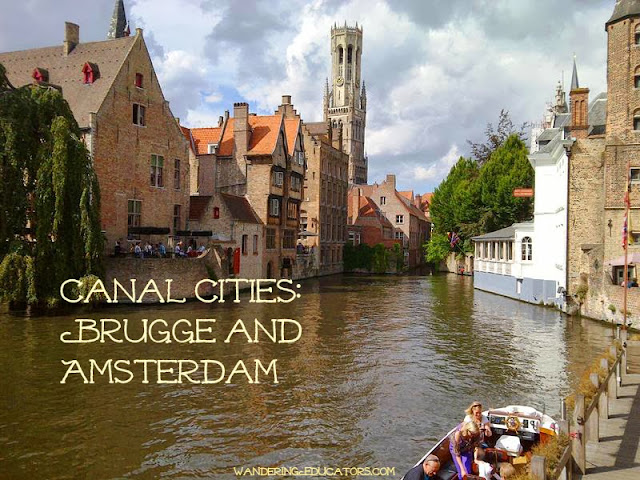
Bruges sneaks up on you too. Bruges soon becomes Brugge, the Flemish spelling dominating almost everywhere. That suits me as I can make myself understood in Dutch although the Belgians will tell you that Flemish is “pure Dutch,” but the Dutch seem to take little notice anyway. Only one missed turn and we were in the old city, right where we wanted to be, at the Hotel Pand, one of the small luxury hotels of the world, and within twenty metres of the most well-known view of Brugge. Perfect.
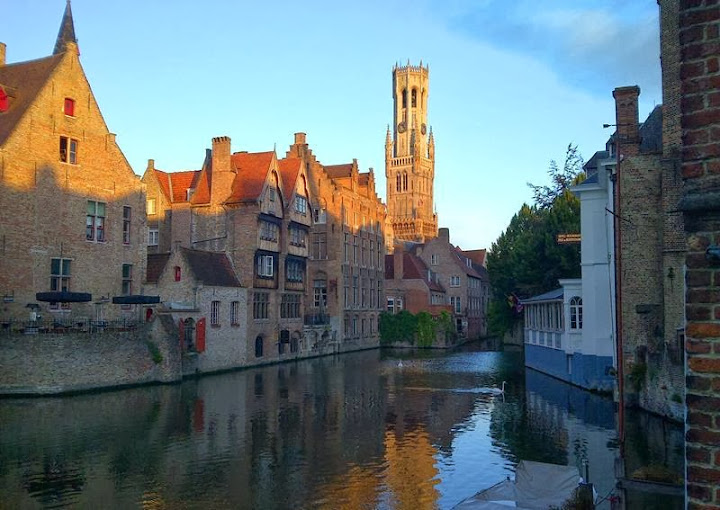
By the boat-load, the most photographed view of Brugge’s Belfry tower.
The wonderful Pand is quite Miss Marple-esque, with chandeliers and lovely comfy sitting areas where she might have had her tet-a-tet sessions with Hercule Poirot or perhaps some chit-chat with TinTin, and in the dimly lit little telephone booth-sized bar, she might have met Audrey Hepburn to discuss charades. There is a lift in which even Twiggy would need to travel sideways, and our room on the third floor was small but with all the appointments and a little bottle of shampoo that you know instantly will finish up in your toiletries bag! The view was one of ‘roof topics’ and the tower of the Belfry. The sun shone, so we headed out to join the throng of strollers, bikers, boaters and eaters, oh yes, above all eaters, for the Belgians do food better than most and they so love their friets, that they even have a museum to the humble chip! You can learn all about how potatoes become friets, how the best ones are prepared, and you get to taste the finished product. Hmmm, I was tempted, but I had to save room for Dutch kroketten, without which no visit to Holland is complete!
Bicycle tyres make rather a slurring sound on cobbles, that last moment whispering death mode of a two wheeled drone. I can understand why ‘Dodge-em Van Damm’ is such a good stunt man, for it is either leap or go down in a heap. And the bikes are heavy and old fashioned too, so when they get the pace up, as they invariably do from the efforts of the stout of thigh gal and guy, simply get out of the way! It was a lesson we learned quickly for in the narrow streets, the footpaths are none too wide, and in central Brugge, if the bikes don’t get you as you step off the footpaths, the horse and cart rides will, although you do hear them coming!
We walked across canal bridges towards the Grand Markt, like the Brussels Grand Place, an eye-wateringly attractive, oddly-shaped ‘square,’ full of huge stone buildings of state and gabled houses now invariably eateries. All were fully stocked with clientele irrespective of the hour, huge glasses of beer and mussels measurable to man by the mounds of residue. The wonderfully ornate Belfry tower, with the city museum at its base, was having a Salvador Dali exhibition and while it melted my heart not to go inside, it was reassuring that the city clocks all still looked perfectly normal. We also passed a number of chocolate shops, prolific in number like the French have boulangeries, and not just full of truffles either! Restrained in the window display true, but Dolly Parton-esque inside, so that even the bras looked tasty, and a darn sight more alluring than those displayed in the sex shop window next door!
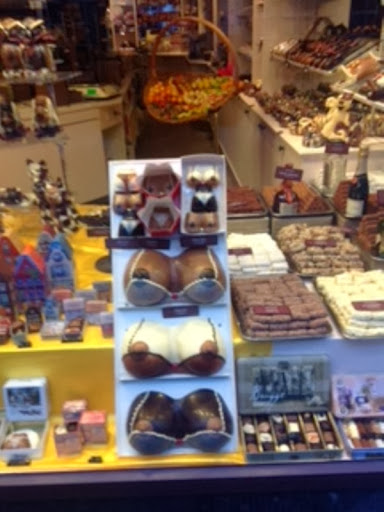
Chocs by the box, for Jocks
The Market Square is the throbbing heart of Brugge with all the arteries feeding in a continuum of ‘sells’ for the shops, restaurants, utilities, tourists behind trotters and back-packing map plotters, who all coagulate there before disappearing along other arteries. The square itself is dominated by a statue of the two leaders of the 1302 Flemish revolt against the French, the key moment in the initial struggle between the French speaking Walloons and the Dutch speaking Flemish, an emnity which has not faded over the following centuries. Just off the Markt are the buildings of the gilt-tinged Burg Square, the 12th Century Basilica of the Holy Blood, looking like a wealthy merchant’s house more commonly found along the canals of Venice, and the Hotel de Ville, the epitome of Gothic ornateness, dating from 1376 and indicative of the richness of the city for over so many centuries.
Tables under the gables in the Markt Square
As a port for the Hanseatic League, Brugge became the centre for trade and commerce with the Mediterranean, particularly the trade in wool and it gave rise to the first bourse or stock exchange, as well as becoming a centre for culture (later the Flemish school of painters), learning, and a place of exile for English kings including the recently dug-up Richard III. William Caxton’s first printing of an English book was done in Brugge. But as with many of the Hanseatic ports, they silted up and in the 15th Century, others like Antwerp took the place of Brugge, to the extent that by 1900, its population had fallen to 50,000 from 200,000 and it was referred to as the ‘Dead City.’ Thank goodness, for much of its medieval-ness was preserved as a result. That is why today, the entire ‘Old city’ is on the UN Heritage listing and walking around its back streets is a most rewarding experience, even if the ancient gables and windows now carry logos from Armani to Zara. Still, given the Belgian penchant for food and drink, there is always a café nearby to rest the feet, put down the shopping bags … and have some reviving friets.
Finding rain in Brugge is like going to the beach and finding sand; you simply expect it. The folk are stoic and accepting and the tourists are too, although invariably less well prepared. Now Amsterdam, Brugge ‘aint, but nevertheless a canal boat ride is mandatory to see the still largely medieval skyline, the bent bridges, the ancient houses of wealthy merchants and the sites of long gone Consulates. And unlike the titanic-sized tourist boats in Amsterdam, all Perspex and plush, the Brugge boats are more life-boat class, windswept and wet when the sun is not shining, but still worth the effort for the sights are superb. And afterwards, there is always a warming, drying café … and some energizing friets.
The next morning we headed for the border, and suddenly we were in the Netherlands, the polder grasslands, the little ditches, the rows of spindly birch trees, pale skies, and yes, the windmills. We sought coffee in the picture-book old village of Goes after an age travelling under the River Maas, but to the horror of café owners busy setting up, we were told, in a most friendly manner mind, that “nothing opens before 10am!” Argh – what about the early risers, all forsaken.
We travelled on to the old Hanseatic port of Zierikzee, in Zeeland, which like Brugge, faded from the limelight through the silting of its port access, and is now a little tourist gem. My father is buried in its graveyard and I came to pay possibly a final call, given our imminent return to Australia and the Southern Hemisphere. He spent the final thirty years of his life, happy as pseudo native of Zeeland and although my brother and I were estranged from him, we kept in touch. Somehow he was buried in a “pauper’s grave” which was repossessed by the Council, who buried him deeper in a now unmarked grave. We were able to get his grave-stone and through the generosity of his local friends, it is now displayed in the local animal shelter, a place he was a volunteer and where he was much loved, more apt than in a church graveyard for one who took his religion with a measure of irreverence. We visited the shelter too, and yes it brought a tear.
Undoubtedly the best stay of our entire travels was in the tiny little village of Serooskerke, so tiny that it is without shops, but not a church, yet is only 12 kilometres from bustling Zierikzee. We stayed at a wonderfully stylish, small B&B, full of artworks and sculptures, De Waag (An 1896 barn which earlier became a restaurant before in 2010, it was converted/modernized by Laura and Dick, good friends of my father (jlgvoorde[at]zeelandnet.nl). They happily showed us around this beautiful part of Zeeland, the dunes, miles of beaches and German bunkers, the woods and the walks along the Scheldt estuary, a font of knowledge, both of them, about the interesting sights and villages nearby.
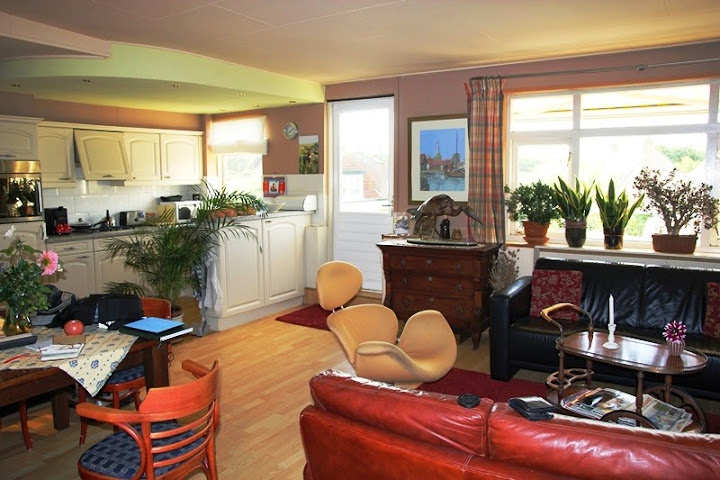
The ‘Guest Lounge’ of the marvelously homey B&B, “De Waag”
The house was lovely with our own huge lounge and terrace, and all modern facilities, a place where simple rest and recuperation came with the tea and coffee. We said farewell with great reluctance.
The Dutch highways, with their excellent and timely signage, their strict adherence to speed limits and general driver courtesy, make driving easy. We zipped under rivers and around Rotterdam, I gave a little salute to The Hague, the city of my birth, oh so long ago, and we stopped just before Amsterdam for a coffee within sight of two windmills in the polder. A taxi-ing 747 rolled directly over our Peugeot and moments later, so did a barge on an elevated canal. The Dutch are to engineering and construction what Norwegians are to seafaring or New Zealanders to rugby. Soon we were in the Overtoom, the thoroughfare leading into the south of Amsterdam, and found the place to park the Peugeot, permanently, after checking in to the Hotel Espresso, a neat and natty niche hotel with coffee on tap at all hours. I am sure I heard Jane give a sigh of relief as I put her in the suitcase!
Amsterdam is a world on two wheels and in glorious sunshine, everyone was out and about, and dogs along for the ride too.
We crossed the Singelgracht (canal), the first of many waterways that girdle much of the old city. Amsterdam has a lot of water to work with and you are seldom far from a canal view or canal edges that are simply … edges with no barriers, so woe-betide parking the car after a few Heinekens and getting it wrong! We only got as far as the very grand State Theatre, off Leidseplein, and succumbed to the krotetten urge, the wonderful deep fried veal croquettes that the Dutch do like nobody else, served with a slice of bread with wonderful mustard. Relaxed youthful waiters, good service, and it being Amsterdam, everyone spoke English.
From there we crossed bridges and canals, everyone another picture, dodging cyclists and trams, and me the shops, past the flower markets with its late bloomers and the centuries old cheese shops selling Old Amsterdam, a hard cheese that looked as though it was centuries old as well. But what a lovely sharp taste when you are actually able to cut slice! We agreed to meet in the Kalverstraat, old Amsterdam’s premier shopping street, now a busy pedestrian mall, while I went first to the Munttoren (Mint Tower – gold and silver coins were once minted there), part of a 17th Century castle tower but turned into a Carillion in 1668 after an earlier fire. On the adjacent Singel canal, barges are anchored along the quay as bicycle parking stations.
The Kalverstraat blends old shops selling cigars, hats-and-spats and coffees from around the world, as well as the latest techno and glam wear. In the 1970s when squatters ran the City Council, it even had a sex shop which hardly fazed the ultra-tolerant Amsterdamers. They are used to sex in their midst with the red-light area on the edge of the city, not far from the Royal Palace on the Dam, and is often included in tour group visits. There are still the cafes too selling hash cookies. The Dam Square remains a lively place for spruikers, buskers and on occasions when the Dutch Royal Family are on display, the irreverent subjects festooned in orange, often bedecked with funny hats and milk-maid plaits. Oh yes, the Dutch are full of cheek.
Nothing to hide: the windows left open at night, so strollers can look in!
Morning light along the Prinsengracht Canal
The sun rises shortly before seven in mid-September and I was up to greet it, and so too appeared to be half of Amsterdam. The canals are like mill-ponds, full of, as Wordsworth so eloquently wrote, the beauty of the morning, silent, bare. The city as though stretching, a few guttural sounds, but not yet the chatter of the day. I wandered past the homes of the martyred Anne Frank and that of Multatuli, the 19th Century Dutch author Eduard Douwes Dekker, who outraged some in society with his novel about the coffee trade and colonial rule amid corrupt Javanese authorities, which significantly changed Dutch colonial thinking. I also walked in the beautiful Begijnhof, hidden by a laneway from the bustling Spui and Kalverstraat, a 14th Century place of the beguines, pious women who took the vows of chastity and aided the nuns in their care for the aged. It is a place of peace and reflection, and in winter is adorned with daffodils and tulips, a jewel in the heart of the city.
The Dutch do breakfasts well with meats, eggs and cheeses, crusty bread, current buns and rusks, porridge and strong coffee, good fare to move mountains and make you oblivious to cold and rain, but aware of things weighty on a glorious sunny day like today. So I ate sparingly (my wife always does) and reminded myself that we had a good walk-it-off journey ahead of us, following the Kaisergracht all the way to the most renown of Amsterdam’s 1200 bridges, the much painted and photographed “Skinny Bridge” (De Magere Brug) on the River Amstel. At night it is adorned with 1200 lights, maybe one for each bridge, and it is always the highlight of night cruises on the canals.
We walked on past the huge Amsterdam auditorium of music and past Rembrandt’s House in Waterlooplein. It was the house he had purchased in 1639 when his fame was ‘popstar-ish,’ but 17 years later, after the painting of his most renown work, The Night Watch (1642-44), the house and its contents were repossessed. Mr van Rijn had lived high on the hog for too long, and beyond his means. He died on 4 October, 1669, which by one of those strange quirks of fate is precisely 344 years to the day as I type this paragraph! He was buried in an unmarked pauper’s grave in Amsterdam’s Westerkerke. At least we know where our father lies, but alas he left no canvasses.
Nearby is an outlet of De Koninklijke Porcelyne Fles, the famous Delft Blue which is as renown as being from “Holland” as tulips, clogs, Philips and Shell. Priceless pieces were on locked display, expensive ones within reach, and the mass produced ‘cheapies’ in great demand by the hordes of tourist who had just come from a major Diamond house and possibly sought, “something a little more affordable!” Besides, the excellent Douwe-Egberts Dutch coffee was free. We bought a couple of souvenirs but headed to a 15th Century Waag (Weigh House) in Nieuw Markt, once a city gate and now the oldest non-religious building in Amsterdam, for coffee, and a kroket! The Surgeon’s Guild had purchased Rembrandt’s famous painting The Anatomy Lesson of Dr Nicolaes Tulp to hang in De Waag, so the Dutch Master had been here too. We sat, ‘embedded’ in history, watching the passing cyclists and in a rather banal empirical study, determined without fear of contradiction, that seven out of ten so-wheeled women, were blondes!
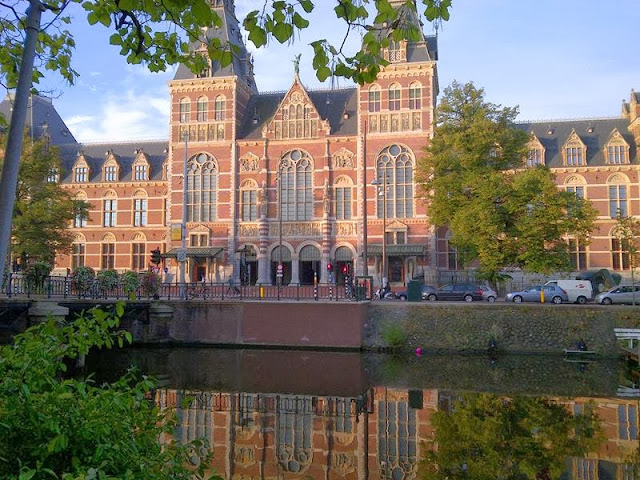
Ahhh, but it was only a short distance from ‘pop-science’ to art, and the afternoon belonged to the newly renovated Rijksmuseum, Amsterdam’s famous art museum, which we had visited twice before. But hey … look at me now, open and airy, a worthy reflection for the Masters who had given the world so many samples of ‘how to paint the light.’ The masterful ‘Nachtwacht’ still had its pride of place, but now hung amid a gallery of ‘equals’ albeit flatter, fuller faces, few with Rembrandt’s richness of shadow, understandable given that all those featured contributed to the painter’s commission and only having half a face in the Mayoral chambers “Was not what I’d paid for, Mr Rembrandt!”
The crowds, as expected, were gi-normous, but I sat long moments waiting for the throng to thin, waiting for those who inch right up to an artwork, or stand in front of everyone else to take a photo, to depart. But the wait was rewarding, a chance to pseudo-commune with the artwork, to look at the detail, feel the cold of Van Gogh’s stare, the wind off the sea at Ruisdael’s windmill, or to imagine a belch from Hals’ “Merry Drinker.” But most of all, there was the way Rembrandt had ‘shone a spotlight’ on three people in a score of the company of guards. Two leading men seize the eye and lead it, but this time I studied the little girl, the flag-waver, I had foolishly ‘missed before.’ It is a remarkable painting, evocative and yes, despite the years, ageless too. Oh there are many great paintings here, but somehow it felt to me that in so many ways, the Rijksmuseum was homage to the Master.


I do love returning each time to the Netherlands as I am sure heritage grips a little more firmly those who are from places distant and can see what an attractive, compact and questioning country it is, full of robustness and impertinence which sits easily with my Australian ethos and upbringing. On our last night in Amsterdam we dined with relatives at the Sama Sebo, the oldest Indonesian restaurant in the city, the famed Rijstafel with more than a dozen pungent, spicy dishes, washed down with beer. One of the relatives gave us a type of Where’s Wally book, a guide to the Netherlands that gave its history and what the country has become, in simple illustrations that needed no language to be understood. It is easy to see why the Dutch are proud of their place in the world, and their land.
I sat at Schiphol airport and thought of cities that morphed into the personalities of people; Rome like Silvio, vino, song, and La Dolce Bambolina; Las Vegas like Tony Blair, all flashy, pretentious and showy, raking in the moolah; Moscow like Pinochet, authoritarian, thuggish, all-watching; and Amsterdam, like Boris Johnson, the Lord Mayor of London, who simply looks like a Dutchman anyway! Unconventional, stunt-prone Boris, wavering between fad and foppishness in his uniquely unkempt way, tousled blond and besotted bicyclist, an eye and a tongue for a good line. But oh what a pedigree, cultural nabob, appreciator of art, seller of cities and bon vivant, raconteur and boulevardier, all rolled into a bundle of excitement and humour. All just like Amsterdam - fun, exciting, inviting, a city which dares … and always has done.
We sat at Schiphol amid the hundreds soon to join us on our 300-plus, U-too-tube, for the flight to Dubai, anxious to board before the Pax Arabica came to put their steamer trunks in the luggage lockers. Like kangaroos at the first rifle shot, the mob was up and bounding at the click of the microphone when I heard the perfectly pronounced “Could Mr Winfred Peppinck come to the check-in desk, please.” Not Winifred, not Pepp-nick or Peppernick, like I get elsewhere. And there, before me in a light-blue ground-staff uniform, was Annike Amsterdam, looking like Aphrodite, tall, blonde hair and azure blue eyes with a smile as wide as a wedge of Gouda cheese, red lipstick and all.
“Your upgrade has come through,” and on the Airbus 380 that simply meant, “Luxury,” or put in Wendy-speak, “Travelling with Verve!”
I watched the take-off through the tail-plane camera, switching to the one in the belly when we were airborne, crossing orange roofed dolls houses, canals and fittingly a windmill, before we caught the clouds.
Winfred Peppinck is the Tales of the Traveling Editor for Wandering Educators
All photos courtesy and copyright Winfred Peppinck




















